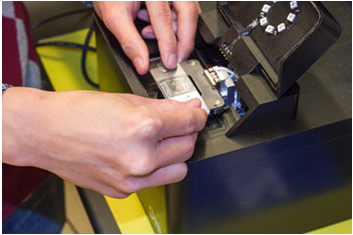Members Login

Channels
Special Offers & Promotions
Oxford Nanoimaging Reports on the Use of their Super-Resolution Nanoimager in the BioMAN Laboratory, Arizona State University in Tempe for the Biophysics Study of Protein Machines
Oxford Nanoimaging Limited manufacture and sell custom microscopes offering super-resolution and single-molecule capabilities to research users.
 The BioMAN Laboratory is led by Professor Rizal Hariadi. Situated in the Biodesign Institute at Arizona State University, the super-resolution Nanoimager is being used to understand cell functionality emerging from interactions between proteins in healthy & disease states.
The BioMAN Laboratory is led by Professor Rizal Hariadi. Situated in the Biodesign Institute at Arizona State University, the super-resolution Nanoimager is being used to understand cell functionality emerging from interactions between proteins in healthy & disease states.
The BioMAN Laboratory is headed up by Assistant Professor Rizal Hariadi. It is located in the Biodesign Institute and in the Physics Department at Arizona State University (ASU) in Tempe. BioMAN is an acronym for the Biomolecular Mechanics And Nanotechnology Laboratory. The Lab’s main interest is to uncover the fundamental physical forces that govern how cells generate, detect, and respond to mechanical forces at the molecular level. The lab uses several techniques including DNA origami scaffolds, protein engineering, tension-sensing peptides, super-resolution microscopy, and cryoEM techniques to measure tension in vitro and in vivo.
Professor Hariadi's goal is to combine single molecule FRET, super-resolution microscopy, and DNA nanotechnology to elucidate how these cellular functions emerge from interactions between single molecules in cells. Currently, the lab focuses on motor proteins and ligases. In a system with a large number of proteins, the elemental reaction steps are averaged out because they are occurring stochastically. Single-molecule experiments enables direct observation of these steps as the ultimate test of the accepted models of these protein machines. Single molecules are much smaller than the diffraction limit of the light microscope. Consequently, it can be difficult to determine interaction with enough spatial resolution to get meaningful insight. In combination with ensemble fluorescence microscope and molecular dynamics simulation, the Lab exploits single molecule localization microscopy to visualize the dynamics and partitioning outer membrane proteins in bacteria. This need led the Lab to the selection of the Nanoimager from Oxford Nanoimaging, ONI.
Professor Hariadi takes up the story. “It was all about timing. I had just taken up my current position at ASU with funding with the need for super-resolution capability to perform single molecule imaging coupled with FRET capability. I spoke at length with ONI founder, Bo Jing, and he convinced me that the Nanoimager would deliver nearly all the performance requirements I defined. His knowledge of super-resolution technology and ability to handle my questions about sample preparation and experimental protocols has been invaluable. This has been further proven in Bo and his colleagues following up to deliver an excellent instrument with a good price point. Compared to other available products, it was the optimal solution for me. I have been very pleased to see the very stable design along with the ability for “perfect focus” through the choice of lenses. The key feature that differentiates the Nanoimager from other systems is the ability for real time image analysis. Usually, I would have expected to have to have to capture data and post-process offline. It is not necessary here - a really unique capability that reinforces my opinion that the unit is so easy and straightforward to use. I note that all components have been carefully selected to make top quality instrument. The latest Hamamatsu S-CMOS camera and choice of powerful lasers further emphasise this. Most recently, ONI has agreed to add temperature control to the Nanoimager which will increase the already excellent level of image stability. While price was important, I now convinced I would have bought the Nanoimager if money had not been in question.”
ASU PhD student, Franky Djutanta, is one of the users of the Nanoimager. He likes “the way the Nanoimager is built. It gives us a straightforward means to acquire the images in a way that requires almost no experimental setup. The hardware and software are so well-thought and well-designed. We truly love this capability since it gives us more time to think about our ideas and science and on to our future papers and personal life as well.”
Media Partners


